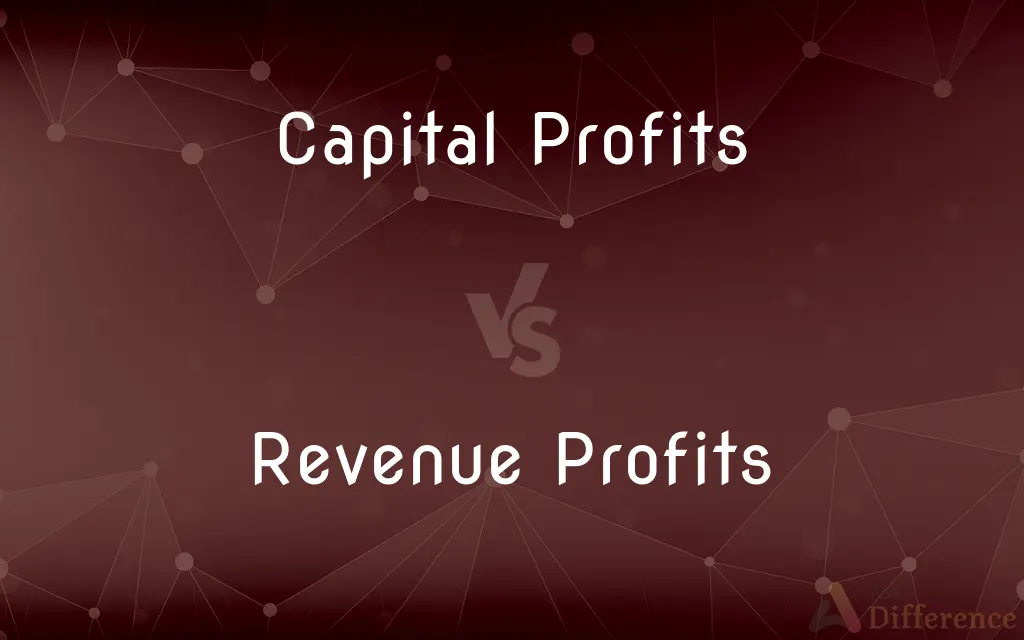Capital Profits vs. Revenue Profits — What's the Difference?
By Tayyaba Rehman — Published on November 23, 2023
Capital profits arise from the sale of fixed assets or investments, while revenue profits result from a company's core business operations.

Difference Between Capital Profits and Revenue Profits
Table of Contents
ADVERTISEMENT
Key Differences
Capital profits are financial gains realized when a company sells its long-term assets, investments, or undertakes activities outside its core business operations. Such profits arise occasionally and are not a recurring feature of a business. On the other hand, revenue profits are the regular and recurring profits earned from a company's primary business activities. These are the profits generated from selling products, providing services, or other core operations.
Capital profits play a pivotal role when a company disposes of its assets, either to revamp its infrastructure or to exit certain investments. These profits, due to their non-recurring nature, may not be the ideal basis for determining a company's ongoing financial health. Revenue profits, however, are central to understanding the firm's operational success. A consistent generation of revenue profits indicates that a company is performing well in its core business areas.
It's important to note that capital profits might be subject to different tax treatments compared to revenue profits. This differentiation arises because the sources of these profits are distinct. Capital profits often result from long-term holdings, while revenue profits are from short-term operations.
Lastly, while both capital profits and revenue profits add to a company's bottom line, they represent different facets of the business. Investors and stakeholders study both types of profit to make informed decisions about the company's financial strength and potential growth.
Comparison Chart
Source
Sale of fixed assets or investments.
Core business operations.
ADVERTISEMENT
Frequency
Occasional, non-recurring.
Regular, recurring.
Tax Treatment
Often different due to long-term holdings.
Typical business income taxation.
Indicates
Asset disposal or investment exit.
Operational success and health.
Use in Decision Making
Assists in understanding long-term asset management.
Central to judging ongoing business performance.
Compare with Definitions
Capital Profits
Profits possibly subject to unique tax treatments.
Due to special tax rules, their capital profits from property sales were taxed favorably.
Revenue Profits
Regular and recurring financial gains.
Due to consistent performance, the firm has stable revenue profits annually.
Capital Profits
Profits derived from the sale of long-term assets.
The company realized significant capital profits from selling its old headquarters.
Revenue Profits
Profits resulting from primary business activities.
The company's impressive sales led to high revenue profits this quarter.
Capital Profits
Financial benefits outside core business activities.
The windfall from the patent sale contributed to the year's capital profits.
Revenue Profits
Gains derived from selling products or services.
Their new software release significantly boosted their revenue profits.
Capital Profits
Gains obtained from the disposal of investments.
After selling its shares in the startup, the firm registered noteworthy capital profits.
Revenue Profits
Financial reflection of operational success.
The rising revenue profits indicated the success of their marketing strategies.
Capital Profits
Occasional, non-recurring financial gains.
The one-time sale of their subsidiary led to substantial capital profits.
Revenue Profits
Typical business income subject to regular taxation.
Their annual revenue profits were subject to standard corporate tax rates.
Common Curiosities
Why are Capital Profits important?
They indicate asset management and the result of investment decisions.
Are Revenue Profits a regular occurrence?
Yes, they recur regularly from core business activities.
How often are Capital Profits realized?
They are occasional and non-recurring in nature.
Why should one focus on Revenue Profits?
They reflect the company's operational success and health.
Which profits are central to business performance?
Revenue profits, as they indicate success in primary operations.
Are consistent Revenue Profits a good sign?
Yes, they indicate stable performance in core business areas.
Can a company have high Revenue Profits and low Capital Profits?
Yes, they can excel in operations but may not sell long-term assets.
Can selling a business unit lead to Capital Profits?
Yes, such sales outside of regular operations result in capital profits.
Are Capital Profits from property sales taxed differently?
Depending on jurisdiction, they might have unique tax treatments.
What are Capital Profits?
Capital profits are gains from the sale of long-term assets or investments.
What are Revenue Profits?
Revenue profits are gains from a company's primary business operations.
Are Capital Profits and Revenue Profits taxed the same way?
Not necessarily. Capital profits may have different tax treatments.
How do investors view Capital Profits?
As an insight into long-term asset and investment management.
Does selling merchandise contribute to Revenue Profits?
Yes, it's a core business activity that adds to revenue profits.
Which profit type helps in judging ongoing business health?
Revenue profits are central to assessing ongoing business health.
Share Your Discovery

Previous Comparison
Social Inclusion vs. Social Exclusion
Next Comparison
Safflower Oil vs. Olive OilAuthor Spotlight
Written by
Tayyaba RehmanTayyaba Rehman is a distinguished writer, currently serving as a primary contributor to askdifference.com. As a researcher in semantics and etymology, Tayyaba's passion for the complexity of languages and their distinctions has found a perfect home on the platform. Tayyaba delves into the intricacies of language, distinguishing between commonly confused words and phrases, thereby providing clarity for readers worldwide.











































